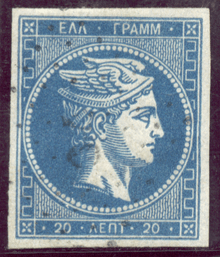Large Hermes head


Large Hermes heads is the name used by philatelists to describe the first issue of Greek stamps, issued in 1861 and used until 1886.
The stamps depict a profile of the Greek messenger god Hermes (Mercury) in a frame strongly resembling that used for contemporary stamps of France. The first set was issued on October 1, 1861. It consisted of seven denominations (1, 2, 5, 10, 20, 40 and 80 lepta). The 30 and 60 lepta stamps were introduced in 1876.
The basic design was by the French engraver Désiré-Albert Barre (1818–1878) and the first batch was printed in Paris by Ernst Meyer. Most types were also printed with control numbers on the back. Further printings took place in Athens and the stamps remained in use until the introduction of the Small Hermes heads in 1886-1888.[1]
Classification of Paris printings
- 1861 - The first seven denominations, 10 lepta with control numbers (Scott 1-7).
- 1876 - 30 and 60 lepta (Scott 49-50). Issued to harmonize international postal rates with those of the Union Genérale des Postes (later Universal Postal Union), which Greece joined in 1875.
Classification of Athens printings
In November 1861 the printing plates were transferred to Athens and subsequent printings were made there, at the National Printing Office. The same plates remained in use into the mid-1880s, resulting in a number of varieties due to plates becoming worn and then cleaned, changes in the exact method of printing and using several different kinds of paper.
Classification of Athens printings is not always easy and there are substantial differences between the various catalogues and specialized publications. Generally the following scheme is accepted, while most experts expand it further with more categories, especially for the period 1861-1862. The Scott catalogue numbers are given for each issue.[2]
- 1861-1862 - Provisional prints (coarse and fine prints) (Scott 8-15)
- 1862-1867 - Consecutive Athens prints[3] (Scott 16-22)
- 1867-1869 & 1873 for the 80 lepta - Cleaned plates issues (Scott 23-29)
- 1870 - special 1 lepton and 20 lepta issues known as "shaved"(Scott 30-31)
- 1871-1872 - prints on paper of inferior quality (Scott 32-37)
- 1872-1876 - meshed paper prints(Scott 38-42)
- 1876 - Paris issue of 30 and 60 lepta
- 1876-1877 - Athens print of 30 and 60 lepta (Scott 51-52)
- 1875-1880 - print on yellowish or cream paper (Scott 43-48)
- 1880-1886 - print on yellowish or cream paper, without control numbers (Scott 53-58)
- 1882 - change of colors print of 20 & 30 lepta
Colours and other characteristics

- 1 lepton - brown, without control numbers
- 2 lepta - bistre, without control numbers
- 5 lepta - green, emerald or light green
- 10 lepta - yellowish orange, often on light blue paper
- 20 lepta - various shades of blue, also aniline rose and carmine in the 1880-1886 issues
- 30 lepta - olive brown, ultramarine after 1880
- 40 lepta - violet, often on light blue paper, lilac-brown, grey-flesh
- 60 lepta - blue-green
- 80 lepta - carmine, carmine rose
Perforations
All large Hermes issues were delivered in imperforate sheets of 150 stamps. The individual stamps were separated at the counter using scissors, resulting in defects in a large proportion of them (cutting off part of the image). However unofficial perforations were produced locally. The most commonly found is the so-called Athens perforation (11½).
1900 Overprints

Large Hermes head stamps were phased out in 1886-1888 with the introduction of the small Hermes head issues. However in 1900, due to delays in delivery of the Flying Hermes series, the Hellenic Post Office decided to surcharge stamp reserves, including large Hermes heads, with new values. Also due to the depreciation of the drachma, stamps were surcharged with new values and A M (value in gold, see article Postage stamps and postal history of Greece for details). The following stamps appeared during this period, both as imperforate and with perforation 11½:
- 30 lepta on 40 lepta
- 40 lepta on 2 lepta
- 50 lepta on 40 lepta
- 3 drachmae on 10 lepta
- 5 drachmae on 40 lepta
- AM 1 drachma on 40 lepta
- AM 2 drachmae on 5 lepta
Three different issues of 40 lepta were used, the 5 drachmae/40 lepta using stamps of the 1868 cleaned plates issue. The 1900 overprints remained in use until 1901.
Forgeries
The stamps have been the target of forgers, including Erasmo Oneglia[4] and A. Alisaffi.[5]
See also
References
- ↑ C. Starenios, ed. (2005). Vlastos Hellas I. Orestes Vlastos Ltd. pp. 1–34.
- ↑ A table with numbers' equivalences for the major catalogues (Yvert, Michel, Stanley-Gibbons and Scott) are given in Vlastos catalogue Hellas I.
- ↑ O. Vlastos classifies the May 1862 print separately as First definitive Athens issue.
- ↑ Lowe R. & Walske C. (1996) The Oneglia Engraved Forgeries Commonly Attributed to Angelo Panelli. London: Robson Lowe. ISBN 9963579736
- ↑ Tyler, Varro E. (1991) Philatelic Forgers: Their Lives and Works. Revised edn. Sidney, Ohio: Linn's Stamp News, Amos Press, pp. 2-3.
External links
-
 Media related to Large Hermes head stamps at Wikimedia Commons
Media related to Large Hermes head stamps at Wikimedia Commons
